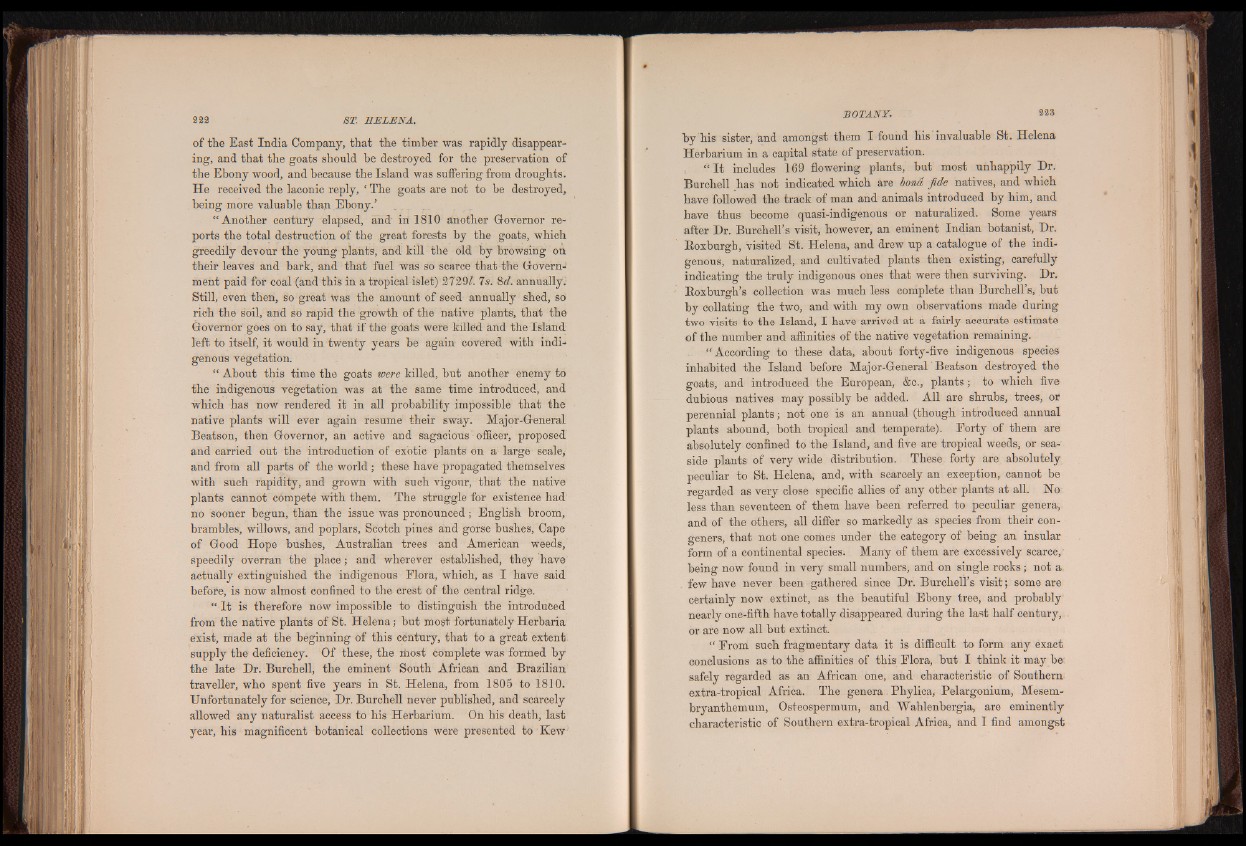
of the East India Company, that the timber was rapidly disappearing,
and that the goats should be destroyed for the preservation of
the Ebony wood, and because the Island was suffering from droughts.
He received the laconic reply, ‘ The goats are not to be destroyed,
being more valuable than Ebony.’
“ Another century elapsed, and1 in 1810 another Governor reports
the total destruction of the great forests by the goats, which
greedily devour the young plants, and kill the old by browsing on
their leaves and bark, and that fuel was so scarce that the Govern-'
ment paid for coal (and this in a tropical islet) 2729/. 7s. 8d. annually.
Still, even then, so great Was the amount of seed annually shed, sd
rich the soil, and so rapid the growth of the native plants, that the
Governor goes on to say, that if the goats were killed and the Island
left to itself, it would in twenty years be again covered with indigenous
vegetation.
“ About this time the goats were killed, but another enemy to
the indigenous vegetation was at the same time introduced, and
which has now rendered it in all probability impossible that the
native plants will ever again resume their sway. Major-General
Beatson, then Governor, an active and sagacious officer, proposed
and carried out the introduction of exotic plants on a large scale,
and from all parts of the world ; these have propagated themselves
with such rapidity, and grown with such vigour, that the native
plants cannot compete with them. The struggle for existence had'
no sooner begun, than the issue was pronounced/' English broom,
brambles, willows, and poplars, Scotch pines and gorse bushes, Cape
of Good Hope bushes, Australian trees and American weeds,
speedily overran the place; and wherever established, they have
actually extinguished the indigenous Flora, which, as I have said
befofe, is now almost confined to the crest of the central ridge.
“ I t is therefore now impossible to distinguish the introduced
from the native plants of St. Helena; but most fortunately Herbaria
exist, made at the beginning of this century, that to a great extent
supply the deficiency. Of these, the riiost Complete was formed by
the late Dr. Burchell, the eminent South African and Brazilian
traveller, who spent five years in St. Helena, from 1805 to 1810.
Hnfortunately for science, Dr. Burchell never published, and scarcely
allowed any naturalist access to his Herbarium. On his death, last
year, his magnificent botanical collections were presented to Kew
by his sister, and amongst them I found his invaluable St. Helena
Herbarium in a capital state of preservation.
“ I t includes 169 flowering plants, but most unhappily Dr.
Burchell has not indicated which are bond fide natives, and which
have followed the track of man and animals introduced by him, and
have thus become quasi-indigenous or naturalized. Some years
after Dr. Burchell’s visit, however, an eminent Indian botanist, Dr.
Roxburgh, visited St. Helena, and drew up a catalogue of the indigenous,
naturalized, and cultivated plants then existing, carefully
indicating the truly indigenous ones that were then surviving. Dr.
Roxburgh’s collection was much less complete than Burchell’s, but
by collating the two, and with my own observations made during
two visits to the Island, I have arrived at a fairly accurate estimate
of the number and affinities of the native vegetation remaining.
“ According to these data, about forty-five indigenous species
inhabited the Island before Major-General Beatson destroyed the
goats, and introduced the European, &c., plants; to which five
dubious natives may possibly be added. All are shrubs, trees, or
perennial plants; not one is an annual (though introduced annual
plants abound, both tropical and temperate). Forty of them are
absolutely confined to the Island, and five are tropical weeds, or seaside
plants of very wide distribution. These forty are absolutely
peculiar to St. Helena, and, with scarcely an exception, cannot be
regarded as very close specific allies of any other plants at all. No
less than seventeen of them have been referred to peculiar genera,
and of the others, all differ so markedly as species from their congeners,
that not one comes under the category of being an insular
form of a continental species: Many of them are excessively scarce,
being now found in very small numbers, and on single rocks; not a
few have never been gathered since Dr. Burchell’s visit; some are
certainly now extinct, as the beautiful Ebony tree, and probably
nearly one-fifth have totally disappeared during the last half century,
or are now all but extinct.
“ From such fragmentary data it is difficult to form any exact
conclusions as to the affinities of this Flora, but I think it may be.
safely regarded as an African one, and characteristic of Southern
extra-tropical Africa. The genera Phylica, Pelargonium, Mesem-
bryanthemum, Osteospermum, and Wahlenbergia, are eminently
characteristic of Southern extra-tropical Africa, and I find amongst